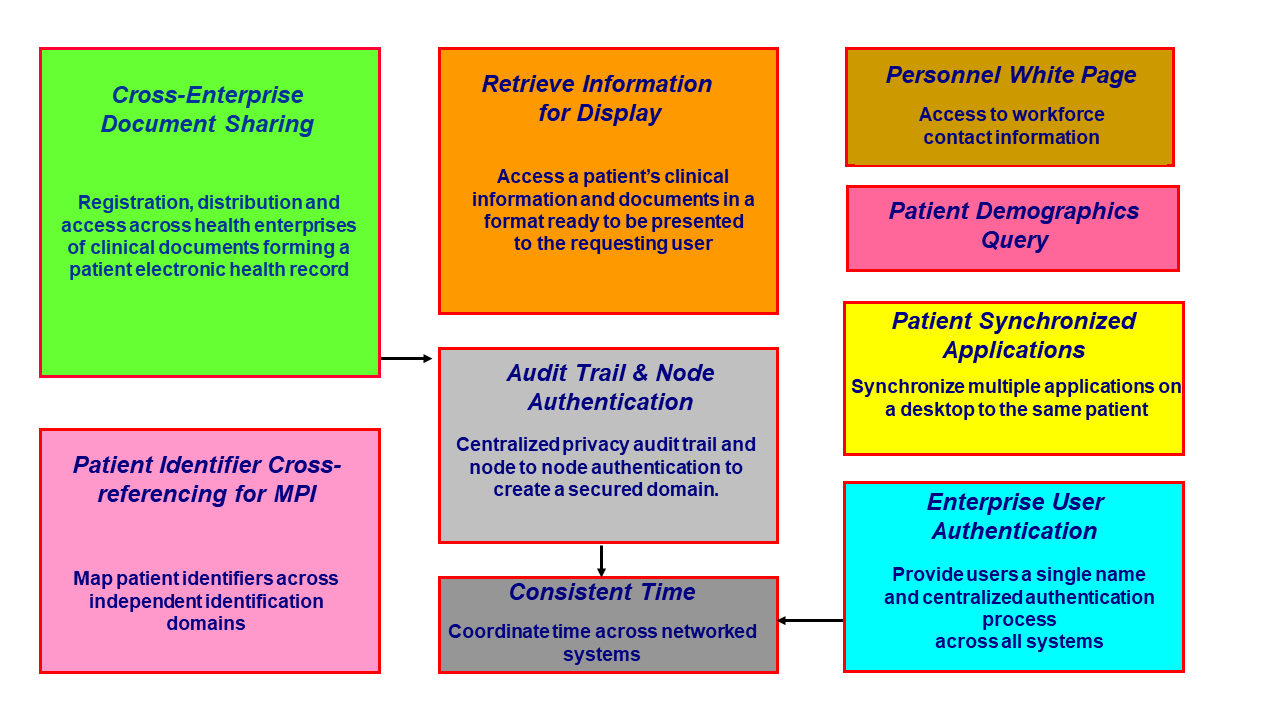2 IT Infrastructure Integration Profiles
IHE IT Infrastructure Integration Profiles offer a common language that healthcare professionals and vendors can use to discuss integration needs of healthcare enterprises and the integration capabilities of information systems in precise terms. Integration Profiles specify implementations of standards that are designed to meet identified clinical needs. They enable users and vendors to state which IHE capabilities they require or provide, by reference to the detailed specifications of the IHE IT Infrastructure Technical Framework.
IHE Integration Profiles are defined in terms of IHE actors (defined in Volume 1), transactions (defined in Volume 2), and content modules (defined in Volume 3). Actors are information systems or components of information systems that produce, manage, or act on information associated with clinical and operational activities in healthcare. Transactions are interactions between actors that communicate the required information through standards-based messages. Content modules define how the content used in a transaction is structured. A content module is specified so as to be independent of the transaction in which it appears.
Vendor products support an Integration Profile by implementing the appropriate actor(s) and transactions. A given product may implement more than one actor and more than one integration profile.
IHE profiles which have reached the status of Final Text are published as part of the domain's Technical Framework Volumes 1-4. Prior to Final Text status, IHE profiles are published independently as Profile Supplements with the status of Public Comment or Trial Implementation.
For a list and short description of IT Infrastructure profiles, see the IHE Wiki at https://wiki.ihe.net/index.php/Profiles. The list includes all of the profiles in this document (Final Text) and may include profiles in the Trial Implementation and Public Comment stage.

Figure 2-1: IT-Infrastructure grouping of Profiles
2.1 Required Actor Groupings and Bindings
The IHE Technical Framework relies on the concepts of required actor groupings and bindings.
Required actor groupings may be defined between two or more IHE actors. Actors are grouped to combine the features of existing actors. This allows reuse of features of an existing actor and does not recreate those same features in another actor. Internal communication between grouped actors is not specified by IHE. An example of grouped actors in the IHE Radiology Scheduled Workflow Profile is the grouping between the Image Manager and Image Archive.
Additionally, required actor groupings may cross profile boundaries. For example, an XDS Document Registry Actor is required to be grouped with an ATNA Secure Node Actor. Required actor groupings are defined in each profile definition in Volume 1. To comply with an actor in an IHE profile, a system must perform all transactions required for that actor in that profile. Actors supporting multiple Integration Profiles must support all of the transactions of each profile. (Note: In previous versions of IHE Technical Framework documents, the concept of profile dependencies existed. For simplification, profile dependencies have been combined with required actor groupings and are enumerated/repeated within each profile in Volume 1.)
Bindings refer to content modules. Bindings map data from a content module to the metadata of a specific transport profile. Bindings for content modules, and the associated concepts, are defined in Volume 3.
2.2 Security Implications
IHE transactions often contain information that must be protected in conformance with privacy laws, regulations and best practices. This protection is documented in the Security Considerations section of each profile, which communicates security/privacy concerns that the implementers need to be aware of, assumptions made about security/privacy pre-conditions and, where appropriate, key elements of a risk mitigation strategy to be applied.
IT Infrastructure has provided Volume 1:1.11 Security Implications
2.3 Profiles Overview
A brief overview of each ITI profile is provided on the IHE Wiki at https://wiki.ihe.net/index.php/Profiles.
2.4 Product Implementations
As described in detail in the IHE Technical Frameworks General Introduction, an implementer chooses specific profiles, actors, and options to implement for their product.
To comply with an actor in an IHE profile, a system must perform all the required transactions for that actor in that profile. To communicate the conformance of a product offering with IHE profiles, implementers provide an IHE Integration Statement describing which IHE integration profiles, IHE actors and options are incorporated.
Further discussion about integration statements and a sample form can be found in the IHE Technical Frameworks General Introduction, Appendix F. To make consumers aware of the product integration statement, enter it in the IHE Product Registry (http://product-registry.ihe.net/).
